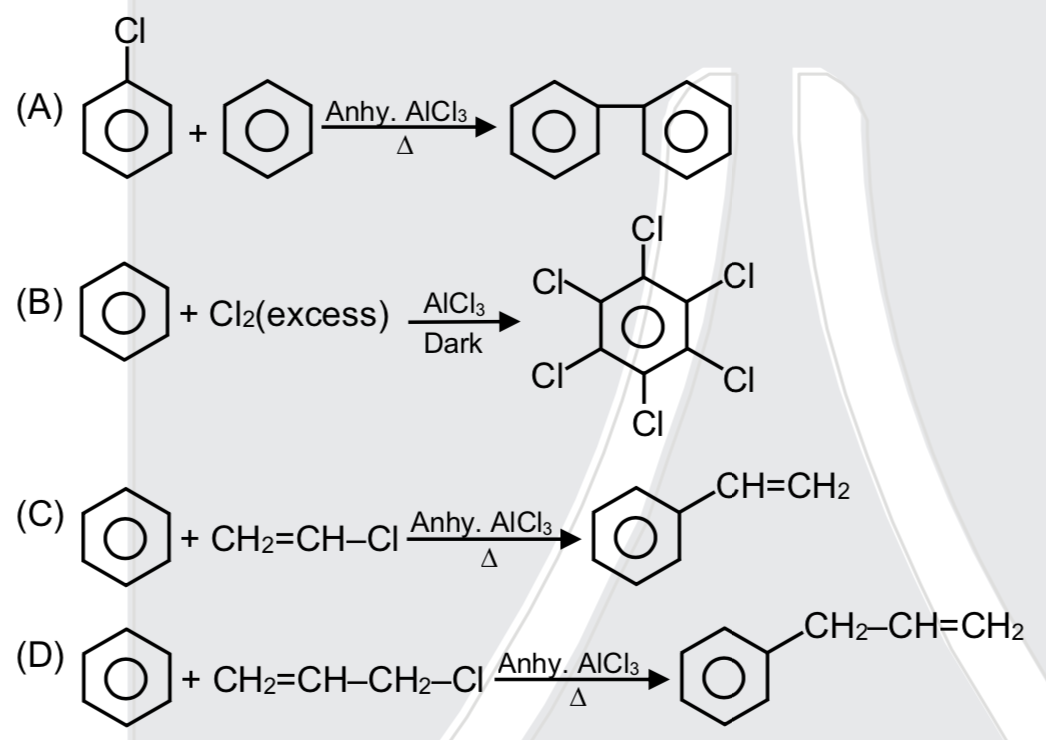Which of the following is/are not possible in case of autocatalysis?
Reactant catalysis
Heat produced in the reaction catalysis
Product catalysis
Solvent catalysis
The correct Answer is:A, B, D
To determine which of the options is/are not possible in the case of autocatalysis, let's analyze each option step by step.
Step 1: Understand Autocatalysis
Autocatalysis is a type of chemical reaction where one of the products of the reaction acts as a catalyst for the reaction itself. This means that the reaction rate increases as the concentration of the product increases.
Step 2: Analyze the Options
We have four options to consider:
1. Reactant Catalysis
2. Heat Producing Reaction Catalysis
3. Product Catalysis
4. Solvent Catalysis
Step 3: Evaluate Each Option
1. Reactant Catalysis: In autocatalysis, the catalyst is formed from the products of the reaction, not from the reactants. Therefore, reactant catalysis is not possible in autocatalysis.
2. Heat Producing Reaction Catalysis: Autocatalysis can occur in reactions that produce heat. The heat produced can sometimes facilitate the reaction, but it does not define autocatalysis. Thus, this option is possible.
3. Product Catalysis: This is the essence of autocatalysis. The product of the reaction acts as a catalyst, thus this option is possible.
4. Solvent Catalysis: While solvents can influence reaction rates, they do not act as autocatalysts. In autocatalysis, the catalyst must be a product of the reaction, not the solvent. Thus, solvent catalysis is not possible in the context of autocatalysis.
Conclusion
Based on the analysis:
- Not Possible in Autocatalysis:
- Reactant Catalysis (Option 1)
- Solvent Catalysis (Option 4)
Final Answer
The options that are not possible in the case of autocatalysis are Reactant Catalysis (Option 1) and Solvent Catalysis (Option 4).
---
Autocatalysis is a type of chemical reaction where one of the products of the reaction acts as a catalyst for the reaction itself. This means that the reaction rate increases as the concentration of the product increases.
We have four options to consider:
1. Reactant Catalysis
2. Heat Producing Reaction Catalysis
3. Product Catalysis
4. Solvent Catalysis
1. Reactant Catalysis: In autocatalysis, the catalyst is formed from the products of the reaction, not from the reactants. Therefore, reactant catalysis is not possible in autocatalysis.
2. Heat Producing Reaction Catalysis: Autocatalysis can occur in reactions that produce heat. The heat produced can sometimes facilitate the reaction, but it does not define autocatalysis. Thus, this option is possible.
Based on the analysis:
- Not Possible in Autocatalysis:
- Reactant Catalysis (Option 1)
- Solvent Catalysis (Option 4)
The options that are not possible in the case of autocatalysis are Reactant Catalysis (Option 1) and Solvent Catalysis (Option 4).
Topper's Solved these Questions
- SURFACE CHEMISTRYBOOK - CENGAGE CHEMISTRY ENGLISHCHAPTER - SURFACE CHEMISTRYEXERCISE - Exercises Single Correct
52 Videos
- SURFACE CHEMISTRYBOOK - CENGAGE CHEMISTRY ENGLISHCHAPTER - SURFACE CHEMISTRYEXERCISE - Single Correct Answer Type
2 Videos
- SURFACE CHEMISTRYBOOK - CENGAGE CHEMISTRY ENGLISHCHAPTER - SURFACE CHEMISTRYEXERCISE - Exercises Link Comprehension
37 Videos
- SOLUTIONSBOOK - CENGAGE CHEMISTRY ENGLISHCHAPTER - SOLUTIONSEXERCISE - Ex 2.3 (Objective)
9 Videos
- SYNTHETIC AND NATURAL POLYMERSBOOK - CENGAGE CHEMISTRY ENGLISHCHAPTER - SYNTHETIC AND NATURAL POLYMERSEXERCISE - Exercises Assertion Reasoning
10 Videos
Similar Questions
Knowledge Check
Which of the following reaction is possible ?
AC6H5OH+HBr→C6H5Br+H2OB(CH3)3CCl+NaOCH3→(CH3)3COCH3+NaClC D
D
Which of the following reaction is possible ?
AC6H5OH+HBr→C6H5Br+H2OB(CH3)3CCl+NaOCH3→(CH3)3COCH3+NaClC D
D
Which of the following reaction is possible ?
AC6H5OH+HBr→C6H5Br+H2OB(CH3)3CCl+NaOCH3→(CH3)3COCH3+NaClC D
D

